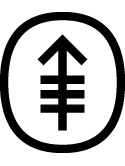Induction of the primary dorsalizing center in Xenopus by the Wnt/GSK/β-catenin signaling pathway, but not by Vg1, activin or noggin Journal Article
| Authors: | Fagotto, F.; Guger, K.; Gumbiner, B. M. |
| Article Title: | Induction of the primary dorsalizing center in Xenopus by the Wnt/GSK/β-catenin signaling pathway, but not by Vg1, activin or noggin |
| Abstract: | The molecular nature of the primary dorsalizing inducing event in Xenopus is controversial and several secreted factors have been proposed as potential candidates: Wnts, Vg1, Activin and Noggin, Recent studies, however, have provided new insight into the activity of the dorsalizing region, called the Nieuwkoop Center. (1) The activity of this dorsalizing center involves an entire signal transduction pathway that requires maternal β-catenin. (2) A transcription factor with potent dorsalizing activity, Siamois, is expressed within the Nieuwkoop Center. We have used these two properties of the Nieuwkoop Center to evaluate the dorsalizing activity of the four secreted factors Wnts, Vg1, Activin and Noggin. The requirement for β-catenin was tested by coexpressing a cadherin, which sequesters β-catenin at the cell membrane and specifically blocks its intracellular signaling activity. Induction of Siamois expression was detected by RT-PCR. Of the four growth factors, only Wnt was sensitive to inhibition of β-catenin activity and only Wnt could induce Siamois expression. Therefore, Wnt is able to induce a bonafide Nieuwkoop Center, while Vg1, Activin and Noggin probably induce dorsal structures by a different mechanism. To order the steps in the Nieuwkoop Center signaling cascade, we have tested the relationship between β-catenin and GSK, a serine-threonine kinase that has been implicated in axis formation in a step downstream of Wnt. We found that GSK acts upstream of β-catenin, similar to the order of these components in the Wingless pathway in Drosophila. We have also examined the relationship between the Wnt/β-catenin pathway and Siamois. We show that β-catenin induces expression of Siamois and that the free signaling pool of β-catenin is required for normal expression of endogenous Siamois. We conclude that the sequence of steps in the signaling pathway is Wnt? GSK? β-catenin→ siamois. |
| Keywords: | signal transduction; controlled study; dna-binding proteins; proto-oncogene proteins; nonhuman; polymerase chain reaction; proteins; animals; animal tissue; reverse transcription polymerase chain reaction; models, biological; transforming growth factor beta; embryo; animal experiment; transcription factor; homeodomain proteins; protein serine threonine kinase; animalia; transcription factors; embryo, nonmammalian; carrier proteins; protein biosynthesis; protein-tyrosine kinases; trans-activators; noggin; dna primers; wnt proteins; growth factor; beta catenin; cadherin; cadherins; repressor proteins; glycoproteins; cytoskeletal proteins; xenopus; wnt; glycogen synthase kinase 3; β-catenin; embryo induction; embryonic induction; xenopus proteins; axis formation; secretory protein; zebrafish proteins; ca(2+)-calmodulin dependent protein kinase; goosecoid protein; activin; activins; female; priority journal; article; inhibins; spemann organizer; siamois; dorsoventral patterning; nieuwkoop center |
| Journal Title: | Development |
| Volume: | 124 |
| Issue: | 2 |
| ISSN: | 0950-1991 |
| Publisher: | Company of Biologists |
| Date Published: | 1997-01-15 |
| Start Page: | 453 |
| End Page: | 460 |
| Language: | English |
| PUBMED: | 9053321 |
| PROVIDER: | scopus |
| DOI/URL: | |
| Notes: | Article -- Export Date: 17 March 2017 -- Source: Scopus |
Citation Impact
Related MSK Work




